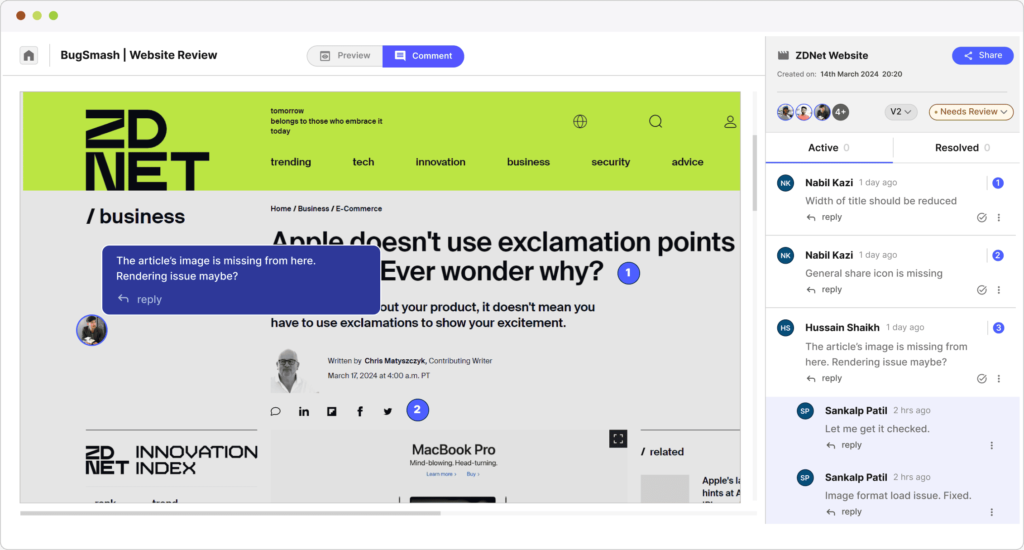
In the intricate world of product management, every step—from conception to launch—is critical. However, one phase often becomes a bottleneck: collecting and managing internal feedback. With team members juggling multiple roles and perspectives, managing feedback without the right tool can feel like trying to catch water in your hands. This is where a website feedback tool with annotation capabilities comes in handy, turning the feedback chaos into a streamlined, productive process.
Let’s dive into the key challenges product managers face when managing internal feedback and how a feedback tool designed for websites, PDFs, and images can make all the difference.
1. The Maze of Feedback Channels
The Challenge:
Product managers often juggle feedback coming in from multiple channels—emails, chats, Zoom calls, even casual office conversations. Feedback gets scattered, critical points are lost in the noise, and keeping track of who said what becomes a mental jigsaw puzzle.
The Solution:
A centralized feedback tool that brings all feedback together—whether it’s for websites, images, videos, PDFs, or app interfaces. Instead of tracking down an email chain or Slack thread, product managers can have everything in one place. This tool not only consolidates feedback but also offers easy-to-use features like markup tools to annotate websites, images, and PDFs. Every piece of feedback is accounted for, organized, and instantly accessible. No more sifting through endless channels.
2. Ambiguity and Lack of Context
The Challenge:
You’ve probably seen it before: vague feedback that says, “The feature isn’t user-friendly,” but with no further explanation. What part isn’t user-friendly? Is it the UI? The workflow? Vague feedback like this can create a ripple effect of confusion and delays.
The Solution:
A feedback tool with built-in annotation features solves this problem. Users can now share website reviews with clear context by using visual aids. Imagine being able to annotate websites, annotate PDFs online, comment on videos, or even mark up images directly on the platform. By allowing team members to point out exactly what’s wrong through screenshot feedback tools, product managers receive more detailed and actionable feedback. No more guessing games—just clarity.
3. Feedback Overload and Prioritization
The Challenge:
In product management, it’s common to receive an overwhelming amount of feedback—some critical, others more like nice-to-haves. Without a way to prioritize this feedback, small, irrelevant suggestions can accidentally take center stage while urgent issues are overlooked.
The Solution:
An efficient feedback tool helps organize feedback into categories and allows for priority tagging. Now, product managers can quickly see which issues are mission-critical and which can wait. This markup tool lets teams easily distinguish between major bugs and minor improvements, saving time and ensuring that the most pressing matters get addressed first. Your team can now focus on what really matters.
4. Collaborative Challenges
The Challenge:
In product development, feedback is rarely isolated to just one person. A designer might flag an issue that needs input from a developer, or a marketing manager might need to chime in on a feature’s user experience. Without a centralized system for feedback, these collaborative discussions can easily get lost.
The Solution:
A collaborative feedback tool with real-time annotation features allows all team members to contribute, discuss, and resolve issues in one place. Whether it’s marking up PDFs, annotating images, sharing feedback on videos, or sharing website feedback, teams can collaborate more efficiently, ensuring everyone is on the same page. This eliminates back-and-forth emails and missed details, allowing teams to brainstorm and finalize solutions quicker than ever before.
5. Tracking Feedback Progress
The Challenge:
Once feedback is submitted, keeping track of what’s been addressed, what’s pending, and what’s been rejected becomes a Herculean task. As product managers, you need to know the status of every piece of feedback, but manually tracking it can be exhausting and inefficient.
The Solution:
A good feedback tool not only gathers input but also tracks the progress of each feedback point. Product managers can see real-time updates on what’s been resolved and what’s still in the queue. This visibility ensures that nothing slips through the cracks, and team members stay informed about the development process. With progress-tracking features, you’ll never lose sight of feedback again.
Conclusion
For product managers, sharing + managing feedback is a balancing act of organization, clarity, and prioritization. With the right website feedback tool, complete with features like screenshot feedback tools, annotation tools for PDFs, images, videos and websites, and collaborative features, handling feedback becomes much more streamlined. This isn’t just a convenience—it’s a game-changer in ensuring that internal feedback leads to actionable improvements and, ultimately, a better product.
Don’t let feedback management bog you down. Start streamlining your feedback process with an online annotation tool and make your product development smoother than ever!
Don’t just manage feedback—Master it 💪🏻




Pingback: 10 Best Product Feedback Tools 2024 – BugSmash Blogs
Pingback: How To Edit a Website: A Step-by-Step Guide For Professional Results – BugSmash Blogs
Pingback: The Essential Website Redesign Playbook: Strategies That Actually Drive Results – BugSmash Blogs
Pingback: How to Get Website Design Feedback That Transforms Your Digital Presence – BugSmash Blogs
Pingback: How Do You Edit Websites: A Complete Guide for Modern Web Design – BugSmash Blogs
Pingback: Expert Review of a Website: Proven Tips – BugSmash Blogs
Pingback: internal communication best practices: Boost Team Success – BugSmash Blogs
Pingback: How to Change Website: 5 Easy Steps to Revamp – BugSmash Blogs